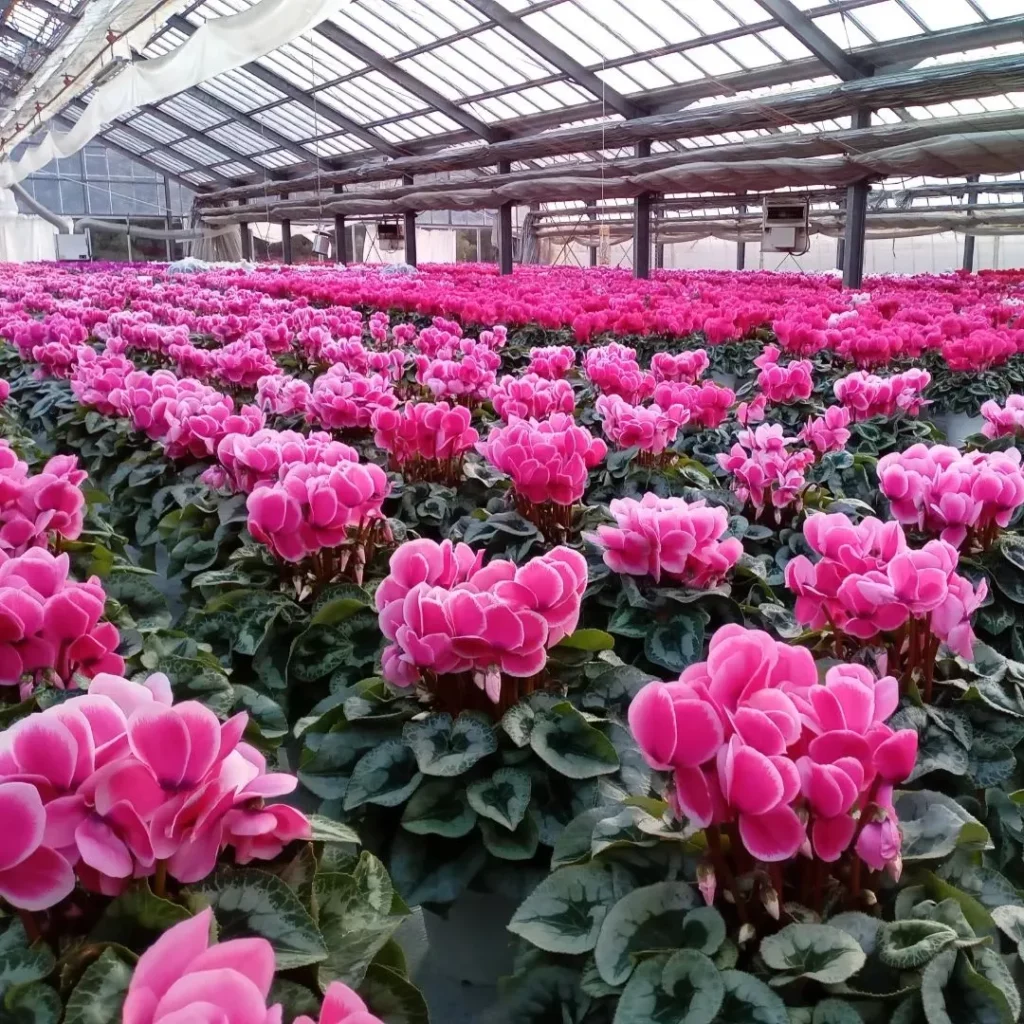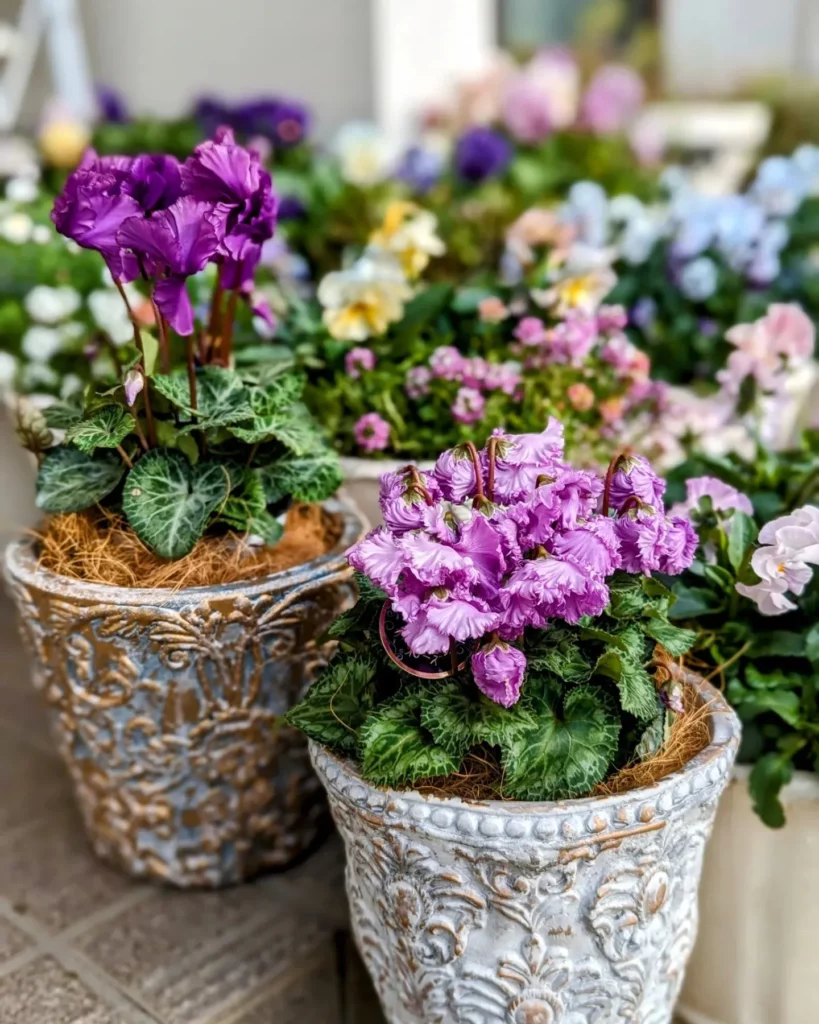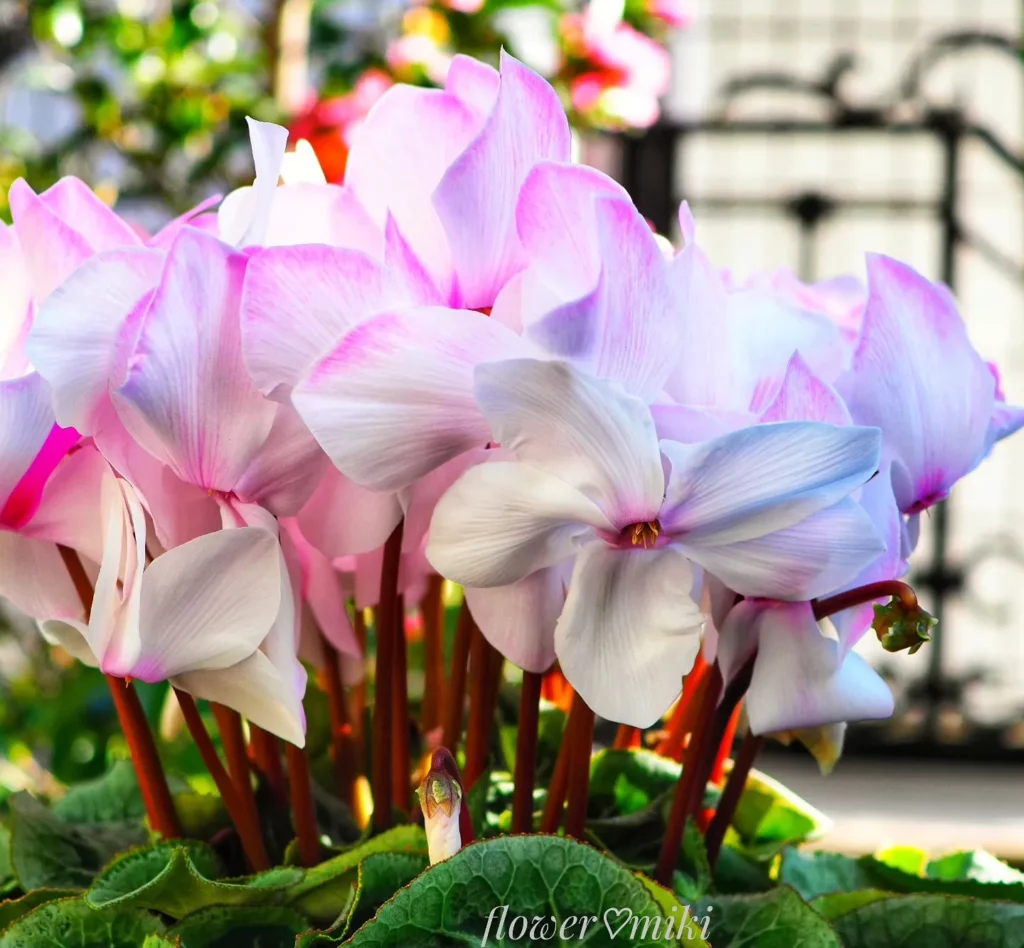Before diving into care routines, it’s essential to understand the appearance of cyclamen plants. Cyclamen features heart-shaped leaves with intricate patterns and vibrant colors, such as white, pink, red, or purple. The flowers are elegant and upward-facing, adding a touch of beauty to any space. Knowing these characteristics will help you identify and care for your cyclamen effectively.
Proper Lighting Requirements for Cyclamen

Light is a critical factor in ensuring the overall health and well-being of your cyclamen plant. Whether you have your cyclamen indoors or outdoors, providing the right lighting conditions is essential for optimal growth and flowering.
For indoor cyclamen plants, place them near a window that receives bright, indirect sunlight. Avoid placing them in direct sunlight as this can lead to leaf scorching. If your indoor space lacks sufficient natural light, you can supplement with artificial light using grow lights specifically designed for plants.
When it comes to outdoor cyclamen, they prefer a partially shaded spot. They thrive in regions with mild climates and prefer protection from direct sunlight during the hottest parts of the day. Choose a location with filtered sunlight, such as under a tree or in a garden bed with dappled shade.
Watering Techniques for Healthy Cyclamen Plants

Proper watering is essential for maintaining the health and vitality of your cyclamen plants. By understanding the unique moisture needs of cyclamens and implementing efficient watering techniques, you can prevent stress, wilting, and potential damage to your beloved plants.
To ensure optimum hydration for your cyclamen, here are some valuable tips to guide your watering routine:
- Avoid overwatering: Cyclamens are sensitive to excessive moisture, so it’s crucial to prevent waterlogged conditions. Allow the top inch of the soil to dry out between waterings to avoid water accumulation and potential root rot.
- Observe moisture needs: Cyclamens prefer evenly moist soil, inhaling deeper irrigation while exhaling superficial dryness. Keep a balance in the moisture level, neither letting the soil become bone dry nor overly saturated.
- Choose the right watering method: Instead of splashing water directly onto the plant or leaves, it’s best to water cyclamens at their base to avoid moisture-related diseases. This method allows the roots to absorb the water effectively and reduces the risk of fungal growth.
No products found.
Pay attention to the signs that indicate your cyclamen’s watering needs:
- Wilting foliage: If you notice drooping or limp leaves, it may be a sign that your cyclamen needs water.
- Dry soil: Check the moisture level of the soil by inserting your finger about an inch deep. If it feels dry, it’s time to water.
- Yellowing leaves: Yellowing leaves can indicate both overwatering and underwatering. Regularly check the moisture level and adjust the watering accordingly.
Fertilizing Strategies for Thriving Cyclamen

Proper nutrition is essential for the healthy growth and vibrant blooms of your cyclamen plant. By providing effective fertilization, you can ensure that your cyclamen receives the necessary nutrients for optimal development. Here are some strategies to help you fertilize your cyclamen and promote its overall well-being:
-
Choose the right fertilizer: Look for a balanced, water-soluble fertilizer specifically formulated for flowering houseplants. These fertilizers typically have a balanced ratio of nitrogen (N), phosphorus (P), and potassium (K) that supports growth and bloom formation.
-
Follow the application instructions: Dilute the fertilizer according to the package instructions. Apply the diluted solution to the soil around the base of the cyclamen plant, taking care not to get any on the leaves or flowers. Avoid over-fertilizing, as it can lead to nutrient imbalances and potential damage to the plant.
-
Establish a feeding schedule: Generally, cyclamen plants should be fertilized every two to four weeks during their active growth period, which is typically from fall to spring. However, always refer to the specific fertilizer’s instructions for precise application frequency.
-
Consider supplemental feeding: If your cyclamen is grown in a potting mix that lacks nutrients, or if it’s displaying signs of nutrient deficiency (such as yellowing leaves or stunted growth), you may want to provide additional feeding. Look for a slow-release fertilizer designed for houseplants, and follow the package instructions for application.
Potting Techniques for Cyclamen Plants

Proper potting is vital for the well-being of cyclamen plants. When it comes to potting and repotting your cyclamen, there are a few techniques you should follow to ensure optimal growth and health.
Container Selection
When selecting a container for your cyclamen, opt for one that has drainage holes to prevent waterlogging. This allows excess water to escape and helps prevent root rot. Choose a container that is slightly larger than the current rootball of your cyclamen, providing enough room for future growth.
Using the Right Potting Mix
Use a well-draining potting mix that is specifically formulated for cyclamen or other houseplants. Avoid heavy clay-based soils that retain water and can lead to root rot. A mix consisting of peat moss, perlite, and compost will provide the ideal balance of moisture retention and drainage.
Ensuring Proper Drainage
Proper drainage is essential to prevent waterlogged soil, which can cause root rot and other issues. Before planting your cyclamen, place a layer of small stones or broken pottery at the bottom of the container. This will create a space for excess water to collect and prevent it from saturating the roots.
Propagation Methods for Cyclamen

If you’re looking to expand your cyclamen collection, there are several propagation methods you can explore. Two popular techniques include growing cyclamen from seeds and dividing existing plants. Here, we’ll provide you with step-by-step instructions for each method, allowing you to successfully propagate cyclamen and enjoy the rewards of cultivating new plants.
Growing Cyclamen from Seeds
- Collect ripe seeds from mature cyclamen plants.
- Prepare a well-draining potting mix made of equal parts peat moss, perlite, and sand.
- Moisten the potting mix, ensuring that it is damp but not waterlogged.
- Sow the cyclamen seeds on the surface of the potting mix, gently pressing them down.
- Cover the seeds with a thin layer of vermiculite or perlite to retain moisture.
- Place the pot in a warm and bright location, ideally between 65-75°F (18-24°C).
- Keep the potting mix consistently moist by misting it regularly.
- Germination typically takes 2-3 weeks. Once the seedlings have several leaves, transplant them into individual pots.
- Continue to care for the cyclamen seedlings as you would for mature plants.
Dividing Existing Cyclamen Plants
- Select a healthy and mature cyclamen plant for division.
- Carefully remove the plant from its pot, taking care not to damage the roots.
- Gently separate the tubers, ensuring that each division has a portion of the rhizome attached.
- Inspect the divisions for any signs of damage or disease, discarding any unhealthy portions.
- Prepare individual pots with a well-draining potting mix.
- Plant each division in its own pot, making sure the rhizome is slightly exposed above the potting mix.
- Water the divisions thoroughly, allowing any excess water to drain.
- Place the pots in a location that receives bright, indirect light.
- Maintain regular watering and care routines to promote healthy growth in the divided cyclamen plants.
Managing Growth and Development in Cyclamen

As your cyclamen plant grows, it goes through various stages of growth and development. Understanding these phases will help you provide the proper care and support needed to ensure its longevity and abundant flowering. Here are strategies to encourage healthy growth and vibrant foliage in your cyclamen:
No products found.
- Provide optimal growing conditions: To promote healthy growth, ensure your cyclamen is placed in a location with indirect sunlight and cooler temperatures between 50-65°F (10-18°C). Avoid exposing it to extreme heat or cold.
- Monitor watering: Proper watering is crucial for the growth of your cyclamen. Keep the soil evenly moist but not soggy, allowing the top inch of soil to dry out between waterings. Use room-temperature water to prevent shocking the plant’s roots.
- Implement a fertilization schedule: Feed your cyclamen with a balanced liquid fertilizer every two to four weeks during its active growth phase. Follow the instructions on the fertilizer package for the appropriate dosage.
- Deadhead spent flowers: To encourage continuous blooming, remove faded flowers by gently pinching them off at the stem. This will redirect the plant’s energy towards producing new blooms.
- Manage humidity levels: Cyclamen plants thrive in humid environments. Increase humidity by placing a tray filled with water and pebbles beneath the plant or misting the foliage regularly.
- Monitor for pests and diseases: Keep a close eye on your cyclamen for any signs of pests or diseases. Common pests include aphids, spider mites, and mealybugs. Treat infestations promptly using organic insecticidal soap or horticultural oil.
Dealing with Pests and Diseases in Cyclamen

Despite their resilience, cyclamen plants are not immune to pests and diseases. It’s important to be aware of common issues, such as aphids, spider mites, and fungal infections that can threaten the health of your cyclamen. Fortunately, there are preventive measures you can take to keep your plant thriving.
One of the best ways to prevent pest infestations is to maintain good plant hygiene. Regularly inspect your cyclamen for any signs of pests, such as tiny insects, webbing, or discolored leaves. If you spot these telltale signs, isolate the affected plant to prevent any further spread.
Additionally, avoid overwatering as it can create a damp environment that is conducive to fungal infections.
When it comes to treatment options, there are several eco-friendly ways to address pests and diseases in cyclamen. For instance, you can use insecticidal soap or neem oil to control aphids or spider mites.
These natural remedies are safe for your plant and environment. As for fungal infections, removing affected leaves and improving ventilation around the plant can help combat the issue.
Remember, prevention is key when it comes to dealing with pests and diseases in cyclamen. By adopting good plant care practices and promptly addressing any issues that arise, you can ensure the long-term health and beauty of your cyclamen plant.
FAQ
What are the characteristics of cyclamen plants?
Cyclamen plants have heart-shaped leaves with intricate patterns and vibrant colors. The flowers are elegant and upward-facing, adding a touch of beauty to any space.
What are the proper lighting requirements for cyclamen plants?
Cyclamen plants require the right amount of natural or artificial light. Position them indoors or outdoors based on their lighting needs to ensure optimal growth and flowering.
How should I water my cyclamen plant?
It is crucial to provide adequate water to prevent stressed or wilting cyclamen plants. Learn about proper watering techniques, including how to avoid overwatering or underwatering, and identify signs that indicate your plant’s need for water.
How should I fertilize my cyclamen plant?
Fertilization is essential for the healthy growth and vibrant blooms of cyclamen plants. Discover the best fertilizers, application methods, and frequency to provide the necessary nutrients for your plant’s well-being.
What are the potting techniques for cyclamen plants?
Proper potting is crucial for the well-being of cyclamen plants. Learn about selecting the appropriate containers, using the right potting mix, ensuring proper drainage, and creating a conducive environment for your plant’s root system.
How can I propagate cyclamen plants?
Expand your cyclamen collection by learning various propagation methods, such as growing from seeds or dividing existing plants. Follow step-by-step instructions for successful propagation and enjoy cultivating new cyclamen plants.
How can I manage the growth and development of my cyclamen plant?
Explore different growth stages and developmental phases of cyclamen plants. Discover strategies to support their growth, encourage abundant flowering, and maintain healthy foliage.
How can I deal with pests and diseases in my cyclamen plant?
Despite being resilient plants, cyclamen may still face pests and diseases. Learn to identify common issues, such as aphids, spider mites, and fungal infections. Implement preventive measures and effective treatment options to protect the well-being of your plant.










